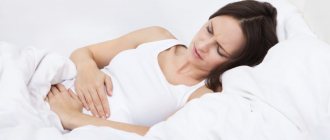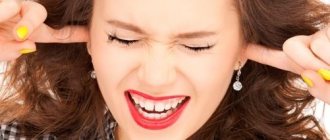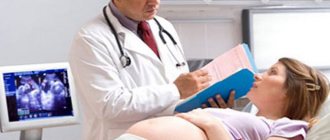Painful sensations in the temporal zone are caused by defensive reactions of our body, indicating an unhealthy state.
It is necessary to find the cause of the pathology in order to properly treat it.
Provoking factors
Headache in the temples and subsequent nausea are provoked by nociceptors located in the head and neck. The nerve tissues of the brain themselves do not hurt because they do not have pain receptors.
Under the influence of a stimulus, the nociceptor sends a signal through nerve fibers to the nerve cells of the brain, as a result, pain appears in the temples.
The mechanisms of headaches are divided into 6 types:
- Vascular headache (VSD). Occurs when venous tone is weakened, dilation and spasm of the arteries, impaired blood supply, accompanied by a delay in blood flow and oxygen starvation.
- Liquorodynamic headache. It occurs due to changes in intracranial pressure, displacement of brain structures against the background of normal ICP.
- Muscle tension headache. It begins with the activation of impulse transmission in the neuromuscular synapse and is caused by muscle tension due to the irritating effect of various factors.
- Neuralgic headache. It is provoked by stimulation of nerves by extraneural and endoneural disorders, pathologies in the parts of the central nervous system responsible for pain relief.
- Mixed headache. It is a combination of the above mechanisms, operating simultaneously or alternately.
- Psychology, or central headache, is caused by disruptions in the metabolism of serotonin, catecholamines and endogenous opiates with subsequent dysfunction of the antinociceptive (pain-relieving) system.
Each factor is accompanied by a reason that answers the question of why a headache occurs; it can be a serious illness, including a life-threatening one.
Symptoms and signs
In addition to headaches in the temples and nausea, the listed diseases may be accompanied by the following symptoms:
- Meningitis : fear of light, sounds, hypertonicity of the extensor muscles (“pointing dog pose”);
- Hypertension : increased blood pressure, dizziness, fainting, tinnitus.
- VSD : symptoms of any diseases of the internal organs, for example, palpitations, diarrhea, vomiting, shortness of breath.
- Sinusitis : runny nose, nasal congestion, ear pain, fever.
- Abscess : significant increase in body temperature (above 39 ° C).
- Stroke : signs of focal brain damage (speech impairment, paresis and paralysis).
Possible complications
The main complication of the listed conditions is the transition of the pathological focus to the substance of the brain . In this case, its damage may be irreversible or reversible.
Symptoms of this condition depend on the area in which the pathological focus is located. For example, this may be the absence of written or oral speech, hearing and vision impairment, complete or partial loss of motor abilities .
Some diseases, such as VSD and migraine, almost never cause complications. They are simply accompanied by unpleasant symptoms and pass quickly.
Possible reasons
The causes of headaches are internal and external. External ones include the following:
- food poisoning or as a result of toxins entering the body in other ways;
- constant stressful conditions;
- prolonged exposure to the hot sun and stuffy rooms;
- abuse of coffee and energy drinks;
- smoking, including passive smoking, alcohol;
- changes in atmospheric pressure during travel, the so-called mountain sickness. Climbing high mountains provokes a change in intracranial pressure, which reduces the supply of oxygen to the brain. People who are not accustomed to such pressure surges feel a severe headache, which goes away when they return to their normal area;
- heightened sensitivity to weather changes.
Internal causes include various diseases; let’s look at the main ones.
Migraine is a very common ailment, it is characterized by severe wave-like headaches, most often in one half of the head - either the right or left temple hurts, the pain spreads to the eye, upper jaw, neck, the attack is accompanied by nausea, sensitivity to light and sound, hypersensitivity to odors . The attack can last from 2 to 72 hours.
The reasons for its occurrence are not fully known, but it has been studied that women are three times more likely to be affected by this disease than men.
Arterial hypertension. In people with moderate hypertension, headaches often have different causes - tension pain, which is psychological in nature, and pain caused by impaired cerebral blood flow. At what pressure they are felt is not important, since they can occur even after normalization of indicators.
With a sharp high jump in blood pressure (hypertensive crisis), there is trembling in the body, the appearance of “floaters” before the eyes and a feeling of heat, increased sweating, dizziness, nausea and vomiting, pain in the temples is accompanied by other types of pain. A hypertensive crisis can trigger a stroke.
Flu, ARVI. Headache and sometimes nausea are signs of intoxication of the body and elevated body temperature.
Encephalitis and meningitis are inflammation of the brain. An acute infectious disease is accompanied by severe headache, nausea, and vomiting. If pain in the head area sharply intensifies when it is tilted towards the chest, then the presence of this symptom may indicate meningitis.
Vasculitis is a group of diseases accompanied by inflammation and destruction of blood vessels. Headache is one of the symptoms of a subtype of vasculitis.
A brain tumor. If there are no pathologies, but in the morning you have a headache in your temples and feel nauseous, you need to see a doctor to rule out the possibility of a brain tumor.
Chronic insomnia is a constant companion for people who have pain in their temples.
Menstrual irregularities cause such unpleasant phenomena as severe headaches, nausea, general weakness, and in rare cases, loss of consciousness.
Traumatic brain injuries in which compression of brain tissue occurs. Head injuries are accompanied by constant or paroxysmal headaches during treatment and after its completion.
An exact answer to the question of why you have a headache can only be given in a hospital, by comparing all the signs with the examination data.
The main reasons for this condition
Headache and nausea are symptoms that occur with both high and low blood pressure.
Causes of increased blood pressure
The brain is one of the most sensitive human organs. Vasospasm leads to swelling of brain tissue. Excitation of the vomiting center occurs due to sudden and strong rushes of blood. Headache and nausea appear.
The reasons for this are:
- exercise stress;
- stressful situations;
- taking tonic drinks (coffee, strong tea);
- alcohol;
- excessive smoking;
- excess body weight;
- age.
High blood pressure has an adverse effect on blood vessels.
Just think what will happen to a rubber tube if it is constantly stretched. After some time, it will lose its elasticity or rupture.
The same thing happens to blood vessels under pressure. The arteries lengthen, increase in diameter, become tortuous, and also become deformed and kinked.
Degenerative changes in blood vessels cause the occurrence of atherosclerotic plaques, blockage and obstruction of veins.
Headache and nausea become common as soon as a person becomes nervous or undergoes excessive physical activity.
Reasons for decreased blood pressure
Lowering blood pressure is a physiological feature of the human body. The lowest blood pressure is recorded in the morning, on an empty stomach, immediately after sleep. You need to know that headache and nausea occur when blood pressure is below 9060 mmHg.
In pathology, the causes may be:
- heart defects;
- exhaustion;
- tuberculosis.
Diagnostics
Diagnosis of nausea and headaches is not an easy task. This may require long-term observation of the patient with a series of studies and tests.
Basic diagnostic methods include taking a medical history, measuring blood pressure, blood tests, examination by a neurologist, X-ray of the head and neck, CT or MRI of the brain, if necessary, a spinal puncture is performed.
The presence of a problem should not be solved by simply treating the symptoms, as this can worsen the disease. Manifestations of pathology require immediate and high-quality therapy.
Health care
Frequent dizziness with high blood pressure requires the help of a qualified doctor. Before starting treatment, the doctor examines the patient, studies symptoms, collects anamnesis, and measures blood pressure. With the help of examinations, the doctor finds out why there is high blood pressure, headaches and nausea. The clinical picture under consideration may be associated with congenital narrowing of the aorta, renal and endocrine diseases, and pathology of the adrenal glands. Similar symptoms occur with tumors of the brain.
Drugs from certain pharmacological groups can increase blood pressure. To relieve headaches, they take adrenergic blockers, diuretics, and ACE inhibitors. The therapist decides which drug will relieve the symptoms for each patient individually.
In the fight against occipital pain syndrome, which is accompanied by nausea with high blood pressure, it is recommended to place a Nitroglycerin or Validol tablet under the tongue. The described clinical picture manifests itself during a hypertensive crisis, so you need to act correctly and quickly. Then you need to call an ambulance.
If you have a headache with high blood pressure, it is recommended to restore your breathing. To do this, the patient must take a deep breath, and while holding his breath, exhale slowly. The exercise is performed in a lying position. It is repeated several times. If there are mustard plasters, they are applied to the calves. You can make a foot bath. The feet are kept in hot water for 15 minutes. A similar manipulation is carried out regarding the hands.
First aid
There are situations when it is not possible to quickly turn to a specialist for help.
It is necessary to understand what priority measures need to be taken. The patient must be provided with peace, relieved of external irritants (pungent odors, stuffiness, etc.). A compress of wet cloth is placed on the forehead, to which you can add a drop of mint or lavender oil.
During the development of pain, doctors recommend taking non-steroidal anti-inflammatory drugs (NSAIDs). If the pain is accompanied by severe nausea, medications are given by injection.
If you have a tonometer, your blood pressure is measured, and depending on the readings, medications are taken to normalize it.
Therapy
Before seeking the advice of a doctor or the arrival of an ambulance, you can partially relieve the pain with the help of medications.
With low blood pressure, the headache goes away after taking caffeine-containing drugs (Askofen, Citramon, Pentalgin), herbal medicines and anticholinergics (Bellataminal).
They also recommend:
- take a horizontal position and place a pillow under your feet;
- strong sweet tea or coffee with sugar.
- ensure the supply of fresh air;
- cold and hot shower;
- massage of the head and collar area.
With elevated blood pressure, headaches can be relieved with thiazide diuretics (Diuril, Naklex) or other diuretics (Veroshpiron, Diursan).
In addition to the above drugs, it is recommended:
- applying mustard plasters to the back of the head;
- circular massage of the occipital region;
- foot baths (with water temperature no higher than 45 C);
- rubbing the eyes.
It is not recommended to try to cure hypertension on your own, since traditional methods are only an addition to the course of therapy prescribed by a doctor.
Your blood pressure has returned to normal, but your head still hurts?
You can get rid of pain with the help of medications, such as “Ascopar”, “Combispasm”, “Solpadeine” and others.
There are also simple methods:
- cold water compress on the forehead and occipital area;
- in case of severe pain, take a hot foot bath;
- ventilate the room;
- lie down in complete darkness and silence;
- You can add 3-5 drops of lavender oil to your bath.
The occurrence of cephalgia (headache) can be caused by external and physiological reasons
External causes are: stress, changes in atmospheric pressure, poor nutrition.
Physiological causes should be taken seriously and promptly examined, as such causes may include infectious and severe viral diseases, such as meningitis.
Remember that almost all diseases associated with high blood pressure can lead to serious consequences! Therefore, it is necessary to consult a doctor in a timely manner.
Treatment
After conducting an examination, taking tests, and accurately determining the cause of the pain, the doctor prescribes treatment. The pain therapy prescribed by the doctor will depend on its nature. Nausea and vomiting, headache in the temples are treated in the following ways:
- establishing a sleep schedule, balanced nutrition. They remove fatty foods from the menu for dinner and practice walking in the fresh air. In some cases, patients are recommended soothing teas with herbs - mint, lemon balm, and sleeping pills to combat insomnia. In other words, if you manage to remove the reasons that provoke sleep disturbances, then you can easily get rid of the unpleasant sensations in your head;
- adjustment of blood pressure with medications. A cardiologist or therapist individually prescribes medications against hypertension, which must be combined with a therapeutic diet;
- elimination of intoxication, immediate removal of toxins from the body in case of poisoning;
- etiotropic antibiotic therapy for meningitis;
- for migraines, ergot preparations are considered the most effective;
- treatment with homologous gamma globulin titrated against tick-borne encephalitis virus, together with corticosteroids;
- taking nootropic drugs, antidepressants, muscle relaxants for head injuries. Pain after a traumatic brain injury cannot be left without proper attention. It is important to contact specialists in time, since in some cases, not only brain damage is possible. Trauma can provoke various psychological disruptions, which lead to pain in the head. In this case, full comprehensive treatment should be carried out. Such therapy is carried out after consultation with several specialists at the same time: psychologist, physiotherapist, chiropractor, neurologist;
- surgery to remove pheochromocytoma is the only possible treatment option for an adrenal tumor;
- different methods of treating brain tumors - there are surgical, medicinal, radiation;
- Treatment of menstrual migraine includes taking vitamins and minerals to maintain the body, hormonal medications to stabilize the functioning of the glands, physical exercise and rest, proper nutrition and healthy sleep.
In addition to measures to eliminate the causes, there is symptomatic treatment of headaches, which consists of taking antispasmodics and NSAIDs. But you need to know that long-term use of these drugs can provoke cephalgia.
It should be remembered that the use of medications must be agreed with the attending physician, since self-medication may worsen the patient’s condition.
If attacks of pain recur regularly, become longer and more severe, then you need to seek medical help to solve the problem. There is no need to leave everything to chance.
To combat nausea, it is necessary to use antiemetic drugs of peripheral and central action aimed at blocking serotonin and dopamine receptors. They are administered intramuscularly or intravenously.
But! Medicines only work on this symptom. The cause needs to be treated. Also, during treatment, they adhere to a diet, exclude fatty foods, fast food, coffee, tea, and sweets. Food should be light and steamed.
Drug therapy for headaches
If the causes of headaches are environmental factors (strong odors, prolonged stay in a stuffy room), then it is enough to reduce this impact or simply remove it. In this case, the unpleasant symptoms will also soon disappear.
It is important to remember that you should use medications only after they have been prescribed by your doctor, since uncontrolled use can lead to a worsening of the patient’s condition.
To eliminate headaches caused by migraine, you can use the following groups of drugs:
- Sumamigren - helps to constrict blood vessels, thereby reducing the sensitivity of the nerves.
- Ergotamine – relieves cerebral edema and has a beneficial effect on the central nervous system.
- Caffeine-based medications (coficil) - they are usually combined with analgesics, which together have an excellent effect on the nervous system and relieve pain.
- Antiemetics (cerucal).
- Sedatives (valerian, motherwort) help after the pain attack has stopped.
If a headache in the temples is caused by arterial hypertension, then the following are prescribed:
- Beta blockers (atenolol) are the most effective for lowering blood pressure, but are contraindicated in people with arrhythmias and bradycardia (slow heartbeat).
- Calcium channel blockers (amlodipine, verapamil).
- ACE inhibitors (enalapril).
- Diuretics (Lasix, furosemide).
To treat pain symptoms resulting from cluster pain, drugs containing acetylsalicylic acid and paracetamol are used. To reduce the negative effect on the gastric mucosa, they should be washed down with plenty of water.
Antiemetic drugs are usually used to combat nausea. But it should be noted that they only affect this symptom. And the cause of the pain remains untreated. It is also necessary to exclude fatty foods, fast food, coffee, tea and sweets from your diet during treatment. It is advisable to consume steamed food, light broths, and water. Daily calorie content should not exceed 900-1000 kcal.
There was pain in the temples and nausea
Painful sensations in the head area, which are accompanied by an attack of nausea, are not a rare occurrence for a huge number of people. In this article we will look at the possible causes of pain, as well as a variety of medicinal methods of treating it.
Often, headaches and nausea are not independent diseases, but are only symptoms of concomitant ailments. A headache can bother a person constantly, or be paroxysmal in nature. At the same time, the quality of life of any person decreases.
Treatment of pain in the temples
The selection of medications for the treatment of temporal pain is carried out by a specialized doctor, depending on the cause and etiology of its development, the age and condition of the patient. The main drugs that can be prescribed for temporal pain include:
- Analgesic, antispasmodic and non-steroidal drugs (Ibuprofen, Analgin, Spazmalgon, Paracetamol). The drugs can reduce pain attacks during migraines, point and cluster pain, but do not eliminate the cause of their development.
- Diuretics (Indapamide, Furosemide). Prescribed for blood and intracranial pressure to reduce swelling and remove excess fluid from the body and dilate blood vessels. As a result of a decrease in blood or cerebrospinal fluid pressure on the brain, the pain attack decreases or disappears.
- Glucocorticosteroids (Prednol, Prednisolone). Prescribed for acute vasculitis as an anti-inflammatory and antitoxic agent.
- Beta blockers (Atenolol, Anaprilin, Metoprolol). The drugs are indicated for high blood pressure to reduce the frequency and force of contraction of the heart muscles, as well as prevent arrhythmia.
- Antidepressants (Fevarin, Mianserin). Prescribed in the complex treatment of tension pain, neuroses and migraines of various etiologies.
- Sedatives (Novo-Passit, Nozepam, Valerian). Necessary for the treatment of psychogenic pain, as well as mitigating the impact of psychological factors that cause them.
- Drugs that provide vascular tone (Detralex, Troxevasin). Indicated for age-related or acute vascular diseases, including vasculitis and temporal arteritis.
Depending on the pathology or disease that causes pain in the temples, the doctor makes a diagnosis, prescribes one of the described medications or selects a complex of several drugs. It is not recommended to self-medicate with medications until the causes of pain are determined.











